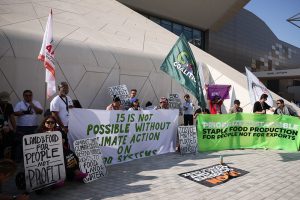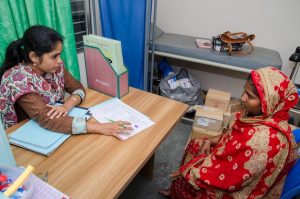
Food and Agriculture for Climate Justice action by Climate Action Network International at COP28 Credit: COP28/Neville Hopwood
By Umar Manzoor Shah
DUBAI & SRINAGAR, INDIA, Dec 21 2023 – Durga Das*, a 59-year-old farmer from the Indian state of Maharashtra, committed suicide last year by ingesting a poisonous substance. He was unable to repay the loan he had taken from the bank for the renovation of his single-story house.
This year, his 32-year-old son, Pradeep Das, a father of two children, is equally desperate. The family owns half an acre of cultivated land where they grow cotton. The harvest has been devastated due to intense heat waves, leaving farmers like Dass and his son Pradeep in dire straits. The loan the family had taken is yet to be paid, and the land they had mortgaged in the bank is about to be confiscated. This means no crops, no cultivation, no business, and no food.
“I would have ended my life long ago, but my kids,” sighs Pradeep.
This family is not alone in such a predicament. About 10,000 farmers in India commit suicide every year. This means 27 every day and about one every hour. Suicides in agricultural communities have been a long-standing issue in the country since the 1970s as farmers face an increasing debt crisis.
“Every day, we are inching closer to death. The summers are getting hotter, extremely hot, and there are no rains. We were hoping to repay the bank the entire amount. Our house was in dire need of repair. The monsoon rain penetrated our home and made us all ill—my kids as well as my mother. We decided to repair it and took out a loan against the land we have. But heaven had something else in store for us,” Pradeep told IPS, explaining the recent uncertain weather patterns.
Based on statistical modeling, researchers predict that if there was a 25 percent deficit in rainfall, the number of farmers dying by suicide in a year would increase to 1,188 individuals; 2023 is already confirmed to emerge as the hottest year ever. Several months this year set new temperature records. More than 80 days this year happened to be at least 1.5 degrees Celsius warmer than pre-industrial times. “Climate change is making agriculture an extremely risky, potentially dangerous, and loss-making endeavor for farmers, and it’s increasing their risk of suicide,” said Ritu Bharadwaj, a principal researcher at the International Institute for Environment and Development (IIED), which conducted the research.
COP 28
From November 29 to December 13 this year, world leaders, climate experts, scientists, and policymakers hailing from 200 countries congregated in Dubai to discuss, debate, and negotiate over the measures needed to be taken to bring down global temperatures and make the earth fit for human habitation.
Despite being the world’s most populous country, India is also anticipated to be the largest contributor to the increased demand for fossil fuels in the next decade. While affluent nations have reduced their emissions by approximately 16 percent since 2007, and China is expected to reach peak emissions before 2030, India’s emissions are poised to surpass those of the European Union. By 2030, India’s emissions are projected to exceed the combined pollution levels of Europe and Japan.
The COP28 climate meeting delivered some important outcomes—a first-time acknowledgment of the need to move away from fossil fuels, a first promise to reduce methane emissions, operationalization and capitalization of the Loss and Damage Fund, and an agreement on a framework for the global adaptation goals.

A lone anti-fossil fuel protestor at COP28. Credit: Umar Manzoor Shah/IPS
However, like all previous COPs, it remained an underachiever, unable to measure up to expectations, particularly in galvanizing more ambitious climate action in the immediate term. The main agenda at COP28 was to carry out a Global Stocktake (GST), a comprehensive assessment of where the world was in its fight against climate change and what more needed to be done to meet the climate objectives.
Meanwhile, millions of farmers like Pradeep in India seem to have no hope of any respite in the times to come. With the recently concluded COP preferring to play a proverbial ostrich in terms of taking a final call on fossil fuel reduction—the prime culprit for the global heat wave—there seems to be no light at the end of the tunnel for India’s crisis-torn farming community. This means more heat waves, a surge in temperatures, and the late arrival of monsoons.
“We could plant good seeds, use quality fertilizer, and make the best human efforts for a profitable harvest, but it is weather that always plays a spoilsport. We cannot escape from its wrath. A farmer would toil for the entire year, and just one single heat wave is enough to dash all his hopes. This is it,” Pradeep said.
Will the Loss and Damage Fund help farmers like Pradeep?
The COP28 climate conference in Dubai marked the official launch of a Loss and Damage Fund designed to assist vulnerable countries in dealing with the consequences of climate change. The initial funding for this initiative is approximately USD 475 million, with the UAE committing USD 100 million, the European Union pledging USD 275 million, the US contributing USD 17.5 million, and Japan offering USD 10 million.
The fund itself represents a global financial package aimed at facilitating the rescue and rehabilitation of countries grappling with the cascading impacts of climate change. Specifically, it involves compensation from wealthy nations, responsible for the industrial growth leading to global warming and the climate crisis, to less industrialized nations. These nations, despite having a low carbon footprint, bear the brunt of rising sea levels, floods, severe droughts, intense cyclones, and other climate-related challenges. The evolving climate has profoundly affected lives, livelihoods, biodiversity, cultural traditions, and identities.
Although the Fund was initially introduced during COP27 in Sharm el-Sheikh, Egypt, it wasn’t until a few weeks before COP28 that rich and poor nations were able to resolve some of their differences and reach agreements on crucial aspects of it.
Highlighting the limitations of the traditional project cycle, Dr Anand Patwardhan, Professor at the University of Maryland, asserts that it is insufficient for addressing the impacts of loss and damage. Emphasizing the importance of recognizing that the ongoing discussion primarily focuses on nations, he underscores the critical need for funds to directly benefit individuals who have undergone loss and damage. He stresses the significance of ensuring access to delivery in this context.
Dr Benito Muller, Managing Director, Oxford Climate Policy, says he doesn’t see this as a fund that spends USD 150 billion annually. “It is very difficult to spend this annually. What this fund should do is not only pilot new funding arrangements but also identify new ways of spending the money, for example, the new insurance schemes.”
Anita Gosh, a New Delhi-based climate activist, says there seem to be no immediate benefits for Indian farmers, even though the Loss and Damage Fund was announced.
“The farmers should be offered comprehensive insurance policies in case of drought-like situations or massive crop damages. The fund should also provide some financial help to the farming communities if they are in distress, like less harvest, marriage ceremonies, or house repairs. The entire idea should be that we must adopt a humane approach towards this community, which is at the receiving end of climate change,” Anita said.
However, she believes the plan for how the fund should be spent is yet to be devised and that she fears it could be shelved for years, as has been the procedure in the past.
“If the past recommendations had been implemented, the situation would have been different today. Now is the time to say enough is enough; we need action on the ground,” Anita told IPS News.
Postscript
During the 14-day period when COP-28 was being held in the opulent Dubai, more than 380 farmers are likely to have killed themselves in India—some for failing to repay the loans, some for failing to pay dowry for their daughter’s marriage, and some for losing hope of giving a good life to their families. But underneath this crisis lurks the prime reason for all these deaths—climate change and the havoc it has been wrecking upon the poor.
Note: The names of the suicide victim and his family have been changed.
IPS UN Bureau Report

